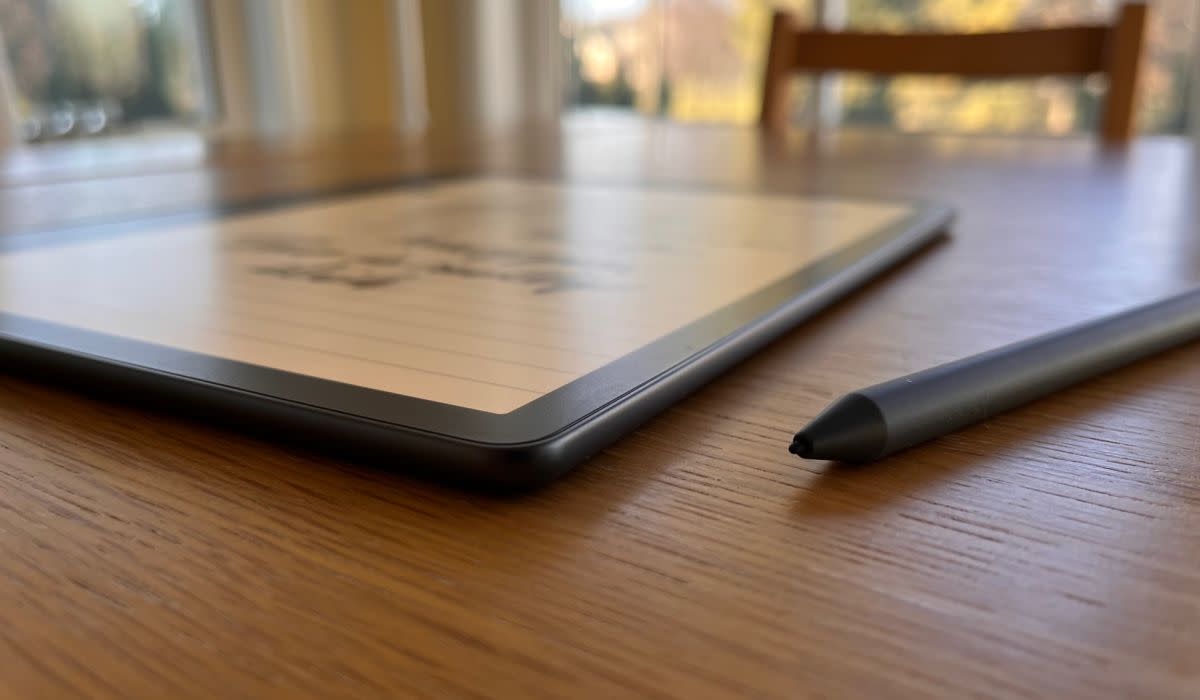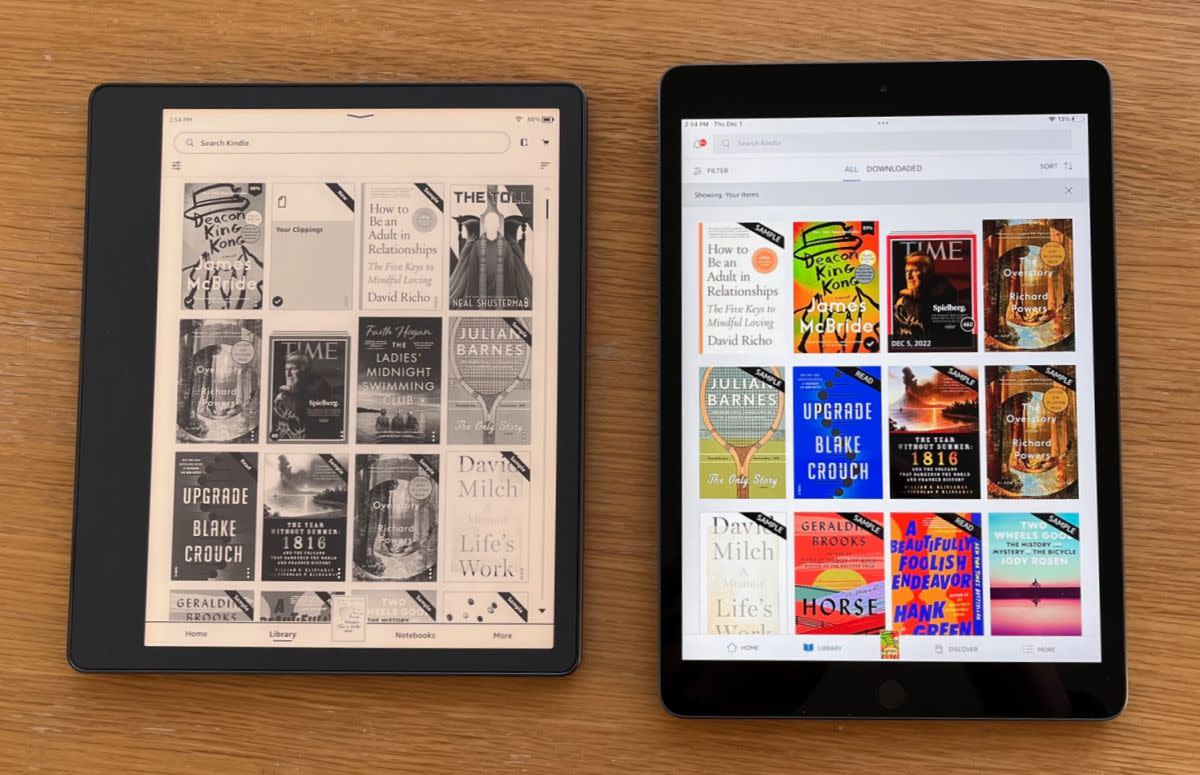Amazon Kindle Scribe review: New updates elevate this writing tablet from good to very good
You already knew the pen was mightier than the sword. Now, it's gunning for the keyboard. The Kindle Scribe is Amazon's first e-reader to include a stylus, one that lets you write directly on the e-ink screen. (In your face, paper!) You can add handwritten digital "sticky notes" to the books you're reading, mark up PDFs and create all manner of full-page documents: lists, journals, sheet music and so on. It's a slick, premium-grade device, one that's surprisingly pleasant to write on, but it has a price tag to match: The Scribe starts at $340 for the 16GB model with Basic Pen. I tested the $390 model that comes with 32GB of storage and the Premium Pen. Would I recommend either of them?
This is an updated version of my original review, one that reflects a number of software-based improvements Amazon rolled out in the months after launch (including four that just arrived). Many of them address problems or limitations I cited previously, resulting in a product I can more wholeheartedly recommend.
But let's first address the flat, rectangular elephant in the room: Why choose a Kindle Scribe over, say, an iPad 10.2 and Apple Pencil? Granted, the latter pair would cost you around $439, but an iPad offers significantly more capabilities than a Kindle — to say nothing of a color screen. And the Pencil affords not only note-taking, but also art creation. (Seriously, you should see what my daughter can do with the Procreate app.)
On the other hand, the iPad handwriting experience isn't quite so paper-like, and battery life is a fraction that of the Scribe's (which promises up to three weeks' worth of writing, based on half an hour per day). iPads can also be quite distracting, with games and videos and whatnot clamoring for your attention. Just as an ordinary Kindle offers a distraction-free reading experience, so does the Scribe leave you alone for journaling.
The value side of my brain says an iPad offers more bang for the buck. The creative side loves the Kindle for its elegant simplicity.
Kindle Scribe: What's it like as an e-reader?
If you've used a Kindle before, there's nothing too revolutionary here except for the size: It's a glorious 10.2 inches, which lets you see a lot more text at once. There's a downside to that, though: Because the screen is wider and taller than most print books, I found I didn't enjoy reading as much. My eyes had a hard time adjusting to the extra movement. Thankfully, like all Kindles, the Scribe offers line-spacing and margin adjustments, which enabled me to create a more comfortable layout.
Landscape mode now supports two-column viewing, a feature I've long enjoyed in the Kindle app for iPad. Curiously, you still have to venture into display settings to toggle between portrait and landscape modes; although the screen can auto-rotate 180 degrees, it can't seem to do 90 degrees without manual intervention.
Whatever orientation you choose, the display delivers a crisp 300 pixels per inch (ppi), resulting in text that's virtually indistinguishable from print. Like most other Kindles, it includes a "warm light" option that softens the LED lighting to a more amber color, nice for evening reading.
The Scribe feels incredibly thin and lightweight when you pick it up, though it does tip the scale at just under a pound. As it happens, the iPad 10.2 is just a hair thicker and heavier. An entry-level Kindle, meanwhile, weighs only 5.5 ounces, so it's much easier to hold for long periods of reading. Although the Scribe has a roomy bezel on the side that makes for a fairly comfortable grip, I did find myself two-handing the device at times.
Indeed, as a straight-up e-reader, the Kindle Scribe isn't ideal; it's a bit too large, heavy and expensive. It lacks physical page-turn buttons, too, though there's so much screen estate that swiping is hardly a hardship. I'd say Amazon's Oasis and Paperwhite Signature Edition are probably the smarter picks for serious readers, but even the baseline Kindle is a great device as well.
Of course, the Scribe isn't intended as a straight-up e-reader; it's also a writing tablet.
Kindle Scribe: What it's like for taking notes?
The Scribe's plastic stylus requires no batteries, no charging and no pairing; it just works. A strong magnet clips it to the side of the screen when not in use, but it could easily get knocked loose in a purse or backpack. I could already feel myself growing concerned about misplacing or losing the Pen, especially given that replacements cost $30 and $60 (for the Basic and Premium versions, respectively).
As noted, I tested the Premium Pen, which adds a dedicated "eraser" (which I discovered I can't live without) as well as a shortcut button. I liked the circumference and heft; it made scribbling on the Scribe feel joyously paper-like — and it even sounds that way, too. There's zero lag between pen strokes and digital ink appearing beneath them; the overall experience really does emulate putting pencil to papyrus.
A small onscreen toolbar, which you can collapse when not needed, lets you choose between pen, highlighter and eraser modes, with a choice of five thicknesses for each of them — plenty for simple note-taking. It also has helpful undo and redo buttons. A recent update added pencil, fountain pen and marker options to the slate of drawing tools, and I was pleased to discover that all these tools are pressure- and angle-sensitive: Lines get thicker when you press a little harder with the stylus or write at an angle.
However, you still can't select and move a chunk of handwritten notes, and there's no handwriting recognition to convert your notes into actual text.
The tablet offers a generous assortment of notebook templates, including numerous versions of lined "paper" as well as a dot grid, graph paper, sheet music, a checklist, day and weekly planners and more. For anyone asking, "Why is this thing better than a pencil and $3 spiral notebook?" there's your answer: On a single device you can have 18 different kinds of notebooks, with enough storage to hold literally thousands of pages.
Meanwhile, you can send just about any kind of file (PDF, Word document, image, etc.) to the Kindle via e-mail (it has a dedicated address) and then use the Pen to add notes. If you have a Microsoft 365 subscription, you'll now find a "Send to Kindle" option in Word, with two available formats: one that lets you write directly on the page, one that limits you to adding virtual sticky notes.
One ongoing disappointment here is that the Scribe can't sync with, say, a Google Drive or Evernote account. In fact, the only way for documents to get on or off the device is via e-mail; those you create on the Scribe are sent as PDFs. And speaking of syncing, any notations you add to an e-book on the Scribe aren't synced to your other Kindle devices or apps (though at least you can access your notebooks).
This is one area where an iPad, as well as competing writing-tablet devices like the Onyx Boox Note Air 2 and Remarkable 2, offers a lot more flexibility. The Scribe makes document creation fun and easy, but it still falls a bit short on document syncing and sharing.
Kindle Scribe: Should you buy it?
What we have here, then, is a big e-reader that's also a writing tablet. It's better at the latter than the former, but it's also improving with age. (For example, another recent update allows you to adjust contrast levels in imported PDFs.)
If you're someone who reads a lot and likes to add notes and highlights along the way, the Scribe is a great tool. Just grab the pen, select some text and then scribble your thoughts. This is vastly superior to the traditional Kindle method of highlighting with your finger and tapping a small onscreen keyboard. But Amazon really needs to (and almost certainly will) update the software so these annotations get synced across devices.
As a basic digital notepad, the Scribe also has its merits; anyone who prefers taking notes by hand to tapping them out on a keyboard will love the smooth, easy feel of the stylus and screen. And although you can't sync those notes anywhere, you can easily dash them off via e-mail.
I like the Scribe more now than I did at launch, but I still see room for improvement. At a minimum, wait for a sale; Amazon devices routinely get discounted, and the Scribe has already dipped below $300 a couple times. No doubt it will do so again for the likes of Mother's Day, Father's Day and Amazon Prime Day.
If you have Amazon Prime, you’ll get free shipping, of course. Not yet a member? No problem. You can sign up for your free 30-day trial here. (And by the way, those without Prime still get free shipping on orders of $25 or more.)


